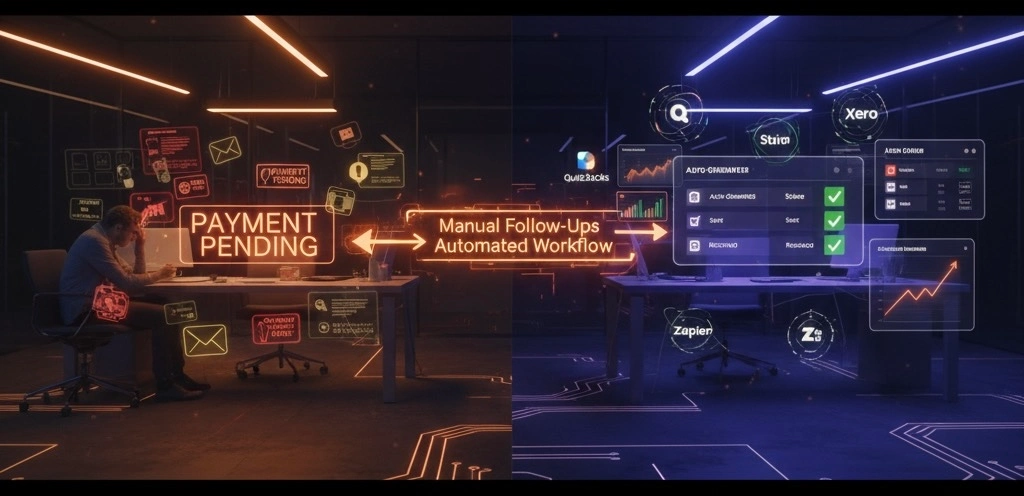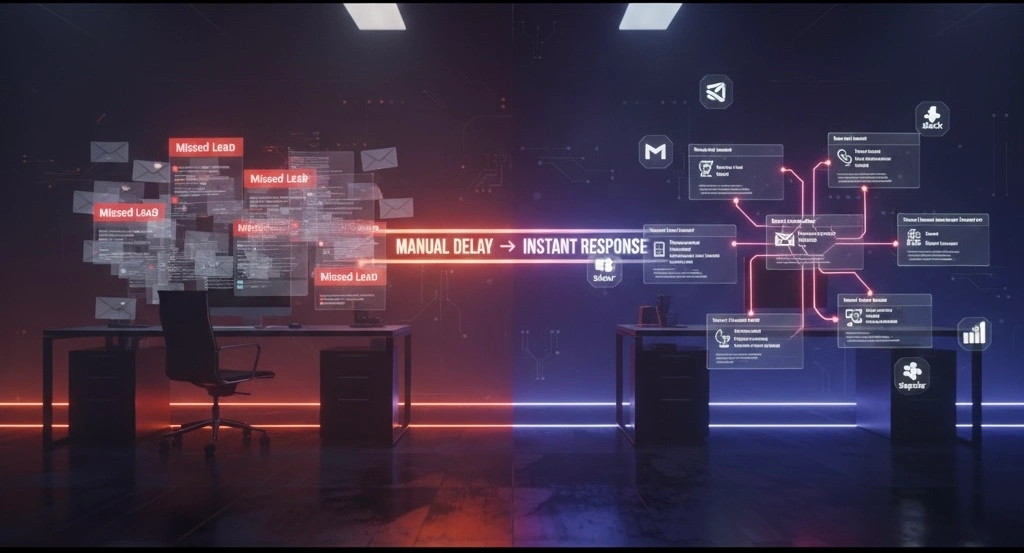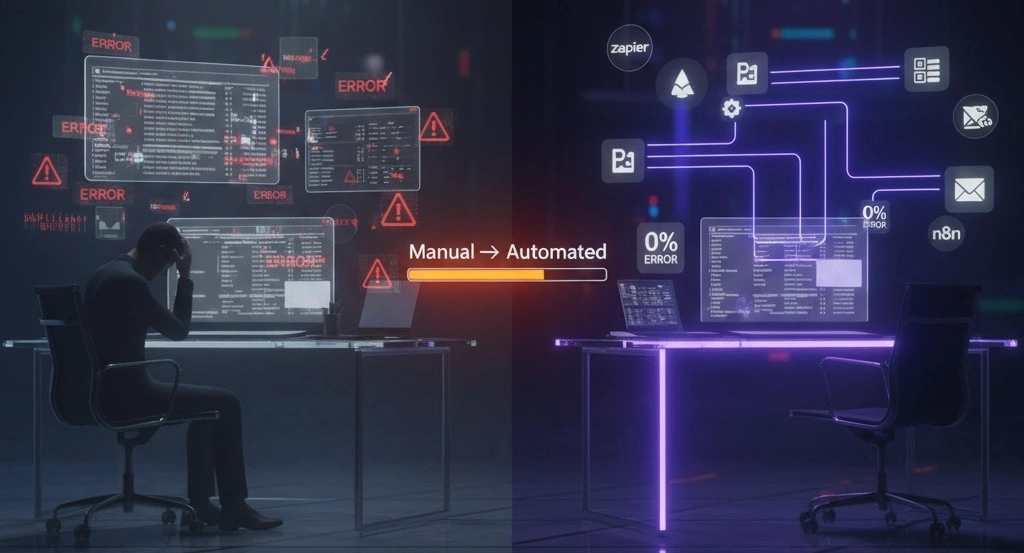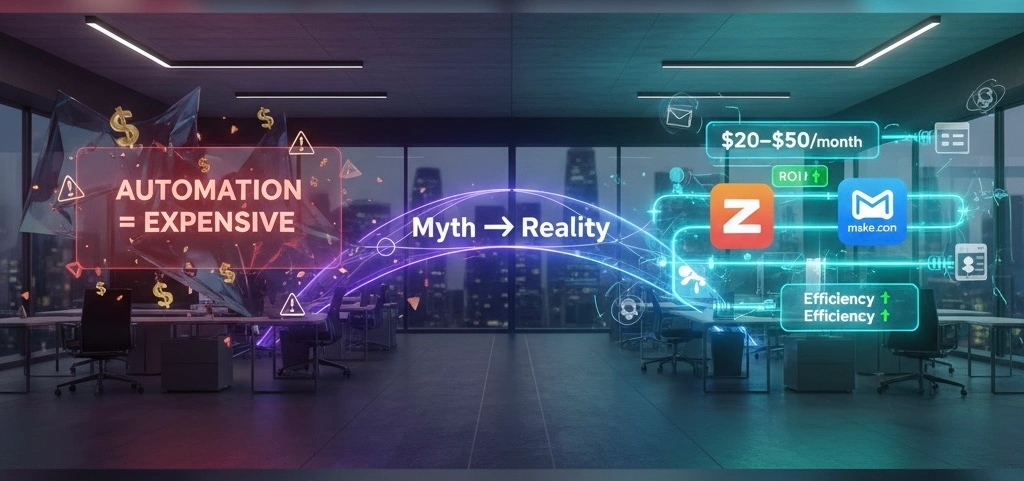Every founder knows the trap. You tell yourself, “I’ll handle it manually—it’ll only take five minutes.”
But five minutes turns into hours. The average employee spends close to three hours a day doing small, repetitive tasks. If you’ve got a team of five, that’s 75 hours every week spent on work that doesn’t create growth.
Those hours are invisible on your balance sheet, but they eat into profit all the same. Copy-pasting data, chasing invoices, writing reminder emails—it’s constant motion with no momentum.
When our AI marketing agency first started, we did everything by hand. It worked… until it didn’t. That’s when I learned that no-code automation services could do the heavy lifting. You don’t need developers. You just need systems that quietly run the background work so you can get back to building.
Task #1: The Data Entry Drain (Copy, Paste, Repeat)
The Pain
Manual data entry is the business version of quicksand. You open one sheet, copy from another, paste into a CRM, fix the formatting—and before you know it, half your morning is gone.
Worse, every manual step invites human error. A single typo can wreck a client record or mess up your reports.
If you’ve ever asked, “Is manual data entry a waste of time?”—yes, it is. It’s one of the biggest operational bottlenecks small teams face.
The Automated Fix
A basic CRM Integration can move information for you. When a lead fills out a form, their details can flow straight into your CRM and Google Sheets automatically.
That’s repetitive tasks automation in real life—simple, quick, and accurate.
We built ours using Make.com in under half an hour. No coding, no consultant fees, and zero human error since.
Task #2: The Invoice & Follow-Up Chase
The Pain
Chasing payments might be the most demotivating part of running a business.
Manually creating invoices, sending them, and remembering to follow up wastes valuable time. When those reminders depend on memory, delays happen—and so do awkward “just checking in” messages.
It’s one of those time-consuming tasks that quietly eats your profit margin.
The Automated Fix
You can now automate invoicing completely.
When a project is marked “Completed,” your no code automation tool can generate an invoice, send it to the client, and even schedule friendly payment reminders. Once it’s paid, the reminders stop.
That single billing automation setup saved us several hours a week and made cash flow smoother.
It’s a small upgrade with a big payoff—and that’s the definition of business efficiency.
Task #3: The Lead Follow-Up Black Hole
The Pain
Every founder fears the silent inbox. A lead arrives, gets buried under tasks, and by the time someone replies, it’s cold. Studies show if you don’t respond within five minutes, your odds of converting that lead drop sharply.
Most teams still track follow-ups manually through notes or spreadsheets. It’s impossible to scale that way.
The Automated Fix
With lead follow-up automation, every new lead gets instant attention.
Here’s what happens automatically: a welcome email goes out, a personalized text follows, a CRM task gets created for your salesperson, and your team gets notified on Slack.
That’s the kind of AI marketing automation that doesn’t replace people—it supports them.
Leads feel cared for, salespeople react faster, and no one forgets a conversation.
Task #4: The Social Media Scramble
The Pain
Staying consistent online matters more than ever, but keeping up with content by hand can quickly become draining. You spend hours planning, scheduling, and posting—and still end up missing days.
It’s not a lack of creativity; it’s the chaos of too many moving parts.
The Automated Fix
A simple no-code automation workflow can fix that.
A simple no-code automation workflow can fix all that mess by just integrating Social Media Automation. All your captions, visuals, and post dates can live in one sheet. From there, automation pushes everything to your scheduling tool or directly to your social platforms.
If you tweak a caption once, it updates everywhere. That’s how to automate repetitive tasks in office workflows without adding another social media manager.
You keep your online presence strong without running yourself into the ground.
Task #5: The Onboarding Paperwork Pile-Up
The Pain
Let’s be honest—first impressions are sufficient to make or break trust. When a new client or employee has to wait around for their contract, NDA, or welcome kit, it feels unorganized. Doing all that paperwork manually slows things down and makes small errors almost impossible to avoid.
The Automated Fix
Onboarding becomes hands-off and smooth, with no-code automation services.
When a deal moves to “Won,” the Client Onboarding Automation system automatically sends contracts for e-signature, triggers a welcome email sequence, and shares any relevant documents.
That’s how to reduce administrative work in a small business—and deliver a great client experience at the same time. It makes you look sharp, saves hours, and builds trust from day one.
Common Myths About Automation (and Why They’re Wrong)
I used to believe no code automation was complicated, expensive, and better suited for big tech companies. Turns out, I was wrong. Let’s bust a few of those myths.
Myth 1: “Automation is expensive.”
Reality: The cost of not automating is higher.
A decent workflow on Make.com or Zapier costs $20–$50 a month. Compare that to the hours your team spends on repetitive work—that’s hundreds of dollars in wasted labor every week.
Automation runs 24/7 and never forgets a task. It’s not an expense; it’s an asset.
Myth 2: “I’ll need a developer.”
Reality: You don’t. That’s the point of no-code.
Tools like Zapier, Make, and Airtable use drag-and-drop logic. You can connect your CRM, billing, and email tools yourself in minutes.
Even advanced setups like lead follow up automation are visual—you can literally see data moving.
Myth 3: “Automation replaces jobs.”
Reality: It takes care of the boring, repetitive parts of the job. By removing the need for manual data entry or endless follow-ups, teams can spend more time on meaningful, creative, and strategic work that actually drives results.
In my own company, productivity jumped 40% because our team finally had time for high-value projects.
Myth 4: “Automation is risky.”
Reality: Manual work is riskier.
People forget steps. Workflows don’t. You can even add approval checks—nothing goes live without a human sign-off.
The result? Errors reduced, tighter control and better outcomes.
Myth 5: “It’s only for large companies.”
The truth is, small businesses often benefit the most. When time and resources are limited, every minute counts. By automating tasks such as invoicing or onboarding, small teams can run smoother, work faster, and achieve the kind of efficiency usually seen in much larger companies.
With modern AI marketing automation, small businesses now compete on equal footing with giants.
In short: automation isn’t the future; it’s the present advantage separating efficient businesses from overwhelmed ones.
Real-World Examples of Manual Tasks to Automate
When people hear “automation,” they imagine robots taking over jobs. What it actually does is remove the tiny, frustrating bits of work that chew through your week. I’ve tested dozens of setups across marketing, finance, and HR. These are the areas that change fastest once you plug in a few no-code automation services.
Marketing and Sales
Leads shouldn’t vanish into inbox chaos. With automation, the moment someone fills out your website form, their info flows straight into your CRM, tagged and ready. Email sequences go out on time, and campaign dashboards refresh themselves. No copy-pasting, no forgotten leads—just smooth business efficiency from first click to closed deal.
Finance and Operations
Money trails hate delay. Automate it and watch the clutter disappear. The second a project wraps, an invoice fires off automatically. When the client pays, your books update and your expense sheet categorizes it in real time. Suddenly cash flow looks less like detective work and more like a live heartbeat.
HR and Onboarding
Paperwork kills excitement. The best teams I’ve seen trigger everything—contracts, welcome kits, policies—automatically once a hire or client is approved. Even leave approvals sync themselves to Google Sheets. The human part stays human; the admin part just…happens.
Social Media and Content
Posting shouldn’t feel like babysitting apps. Keep all your content in one sheet, connect it to a scheduler, and let automation push posts across platforms for you. Analytics update every morning without logging in anywhere. You focus on ideas; the bots handle delivery.
Customer Success
Clients get reminders, follow-ups, or thank-you notes automatically—on time, every time. Feedback forms collect responses in one place. You don’t need to remember who to ping next; the system does. Small touches stay personal because you finally have bandwidth to make them genuine.
Every workflow you automate removes a pinch of friction. Stack a few together and the business starts running smoother than you thought possible.
How to Save Time in Business (The Framework)
Start simple. The goal isn’t to automate everything, just the stuff that steals focus.
Take a good look at how you work—start by noting the tasks you repeat every week.
Tackle the ones that eat up the most time first.
Pick no-code tools that are simple and visual, so you’re not buried in setup.
Add new automations gradually, one at a time, and keep checking what’s working.
Automation isn’t against people—it’s about giving you back the time you never have enough of.
The Future of AI Marketing Automation
Here’s where things get interesting. AI marketing automation is now affordable and shockingly smart. It scores leads before you even open an email, schedules posts based on engagement data, and builds customer journeys that adapt in real time.
When you pair that intelligence with no-code systems, you get a self-tuning growth engine: simple to manage, measurable to the minute, and scalable without more headcount.
The next decade won’t favor the loudest brand. It’ll reward the fastest learners—the teams that automate early, test often, and move before everyone else catches on.
Conclusion: Reclaim Your Time, Reclaim Your Growth
Every “five-minute” task quietly eats away at your day. Add them up and they become weeks of lost progress. Set up automation once for things like data entry, invoices, lead follow-ups, social posts, and onboarding just once—and you’ll notice the difference right away.
Automation isn’t about working less—it’s about freeing yourself up to focus on the parts of the job that really move things forward. It replaces those long, repetitive work with smooth systems running quietly behind the scenes. That’s what genuine efficiency looks like—less chaos, more progress, and no wasted motion pretending to be productivity.











